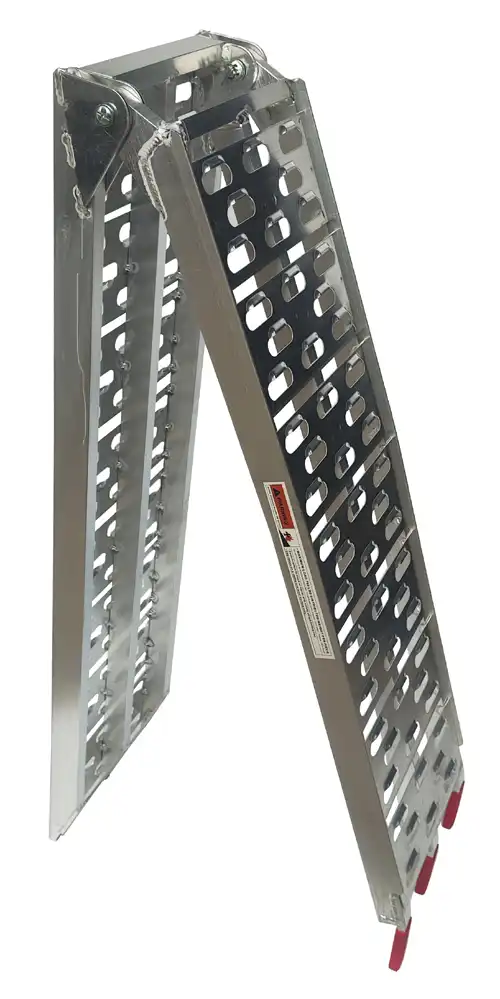Structural Design and Material Composition
Motorcycle Ramp Architecture
Motorcycle ramps are engineered with a sleek, streamlined design to cater to two-wheeled vehicles. These ramps often feature a single, centered track that aligns perfectly with a motorcycle's wheels. The track is typically serrated or textured to provide optimal traction, crucial for maintaining stability during loading. High-quality motorcycle loading ramps are crafted from durable materials like aircraft-grade aluminum, striking a balance between strength and lightweight portability. This composition allows for easy handling and storage while ensuring the ramp can support the weight of various motorcycle models.
ATV Ramp Configuration
In contrast, ATV ramps boast a broader, more robust structure to accommodate the wider stance of four-wheeled vehicles. These ramps often incorporate multiple tracks or a solid platform design to support the ATV's full width. The surface area is generally larger, with aggressive tread patterns or perforations to enhance grip and allow for water and debris drainage. ATV ramps are constructed using heavy-duty materials, such as reinforced steel or thick-gauge aluminum, to withstand the increased weight and stress of larger off-road vehicles. Some models feature foldable designs or detachable sections for convenient transport and storage.
Comparative Strength-to-Weight Ratios
When examining the strength-to-weight ratios of motorcycle and ATV ramps, notable differences emerge. Motorcycle ramps prioritize a lightweight design without compromising on load-bearing capacity. This balance is achieved through innovative engineering and the use of high-strength alloys. ATV ramps, while heavier, offer substantially higher weight capacities to handle the heft of larger vehicles. The trade-off between portability and strength is a key consideration for users when selecting between these two ramp types.
Load Capacity and Safety Features
Weight Thresholds
The load capacity of motorcycle ramps and ATV ramps differs significantly due to the varying weights of the vehicles they're designed to support. Motorcycle ramps typically have a weight capacity ranging from 750 to 1,500 pounds, sufficient for most motorcycles, including heavier touring models. ATV ramps, on the other hand, are built to handle much greater loads, often ranging from 1,500 to 3,000 pounds or more. This higher capacity accounts for the weight of larger ATVs, side-by-sides, and even small utility vehicles. It's crucial for users to verify the weight of their vehicle and select a ramp with an appropriate load rating to ensure safe loading and unloading operations.
Integrated Safety Mechanisms
Both motorcycle and ATV ramps incorporate various safety features, but their implementations can differ. Motorcycle ramps often include safety straps or hooks that secure the ramp to the vehicle or loading surface, preventing slippage during use. Some models feature adjustable height settings to accommodate different vehicle clearances. ATV ramps may incorporate wider, non-slip surfaces and raised edges or side rails to prevent wheels from slipping off during loading. Advanced ATV ramp designs might include hydraulic or spring-assisted lifting mechanisms to ease the deployment and storage process, reducing the risk of injury from manual handling.
Stability Enhancements
Stability is paramount in both motorcycle and ATV ramps, but the approaches to achieving it vary. Motorcycle ramps often utilize a tri-fold design, which provides a compact storage solution while offering a wide, stable platform when deployed. Some motorcycle ramps feature arched designs that optimize the approach angle, reducing the risk of bottoming out during loading. ATV ramps frequently employ a straight or slightly curved design with reinforced cross-members for added rigidity. Some models offer adjustable width options to match the specific track width of different ATV models, ensuring maximum stability during use.
Versatility and Specialized Applications
Multi-Vehicle Compatibility
While designed for specific vehicle types, both motorcycle and ATV ramps offer varying degrees of cross-compatibility. Some motorcycle ramps, particularly those with wider tracks or adjustable configurations, can accommodate smaller ATVs or dirt bikes. Conversely, certain ATV ramps with removable sections or modular designs can be adapted for use with motorcycles. This versatility is especially valuable for enthusiasts who own multiple types of off-road vehicles. However, it's essential to consider the weight capacity and dimensions of the ramp to ensure safe use across different vehicle types.
Terrain Adaptability
The ability to function effectively on various surfaces is a crucial aspect of both motorcycle and ATV ramps. Motorcycle ramps often feature serrated edges or rubberized feet to provide grip on smooth surfaces like garage floors or truck beds. Some models offer adjustable feet to compensate for uneven terrain. ATV ramps, given the heavier loads they handle, may incorporate more aggressive anti-slip measures, such as deeply grooved surfaces or spike-like protrusions that can dig into softer ground. This enhanced adaptability allows for safe loading in a wider range of environments, from paved surfaces to rugged outdoor settings.
Specialized Loading Scenarios
Both motorcycle and ATV ramps cater to unique loading scenarios beyond their primary use cases. Some motorcycle ramps are designed with extra length to accommodate low-clearance sport bikes or custom choppers with extended front ends. These elongated ramps provide a gentler incline, reducing the risk of scraping or damaging the vehicle during loading. In the ATV realm, specialized ramps exist for loading into higher vehicles or trailers, featuring two-stage designs or hydraulic lift assistance. There are also compact, portable ramps designed for emergency field use, allowing riders to navigate obstacles or load disabled vehicles onto rescue trailers.
Conclusion
In conclusion, the choice between a motorcycle ramp, a moto ramp, and an ATV ramp hinges on the specific needs of the vehicle and user. Motorcycle ramps excel in lightweight portability and precise wheel alignment, ideal for two-wheeled enthusiasts. ATV ramps offer robust construction and wider platforms, catering to the demands of larger off-road vehicles. Both types prioritize safety and stability, incorporating features tailored to their intended use. Understanding these key differences enables riders to make informed decisions, ensuring safe and efficient vehicle loading across various scenarios. Ultimately, selecting the right ramp enhances the overall experience of off-road adventures, from transport to trail.
Contact Us
For more information about our high-quality motorcycle and ATV ramps, or to discuss your specific loading needs, please don't hesitate to contact us at info@runva.com.cn. Our team of experts is ready to help you find the perfect loading solution for your off-road vehicles.

_1737625693698.webp)


